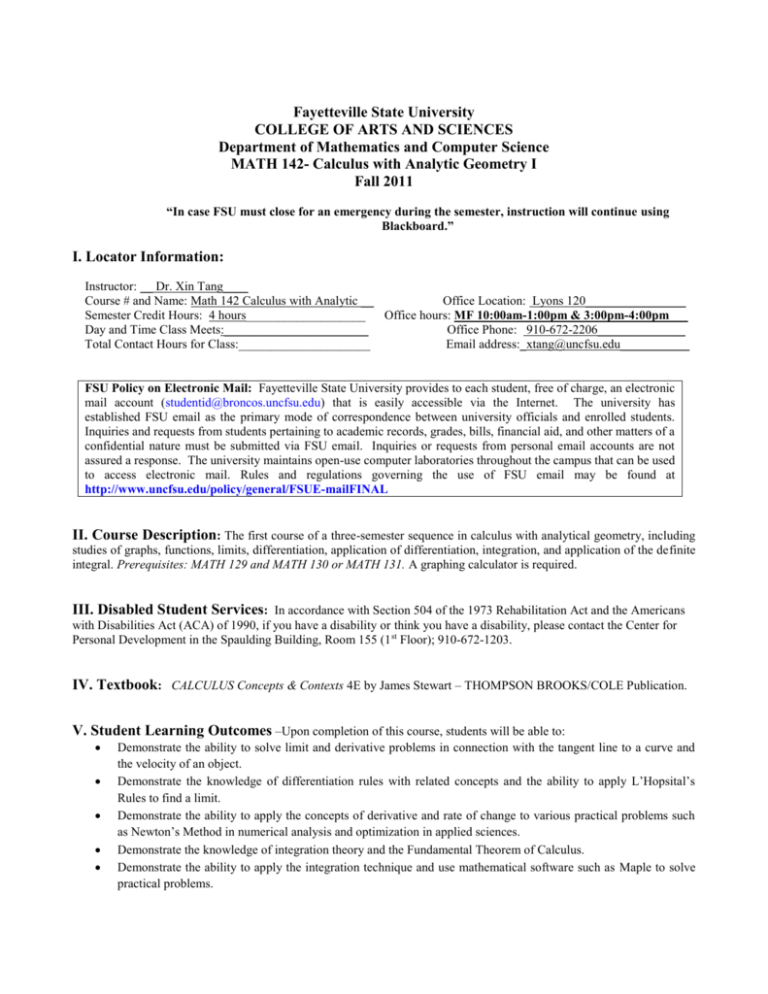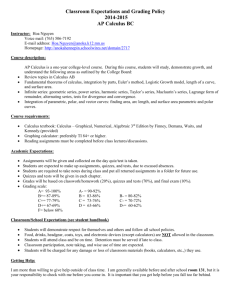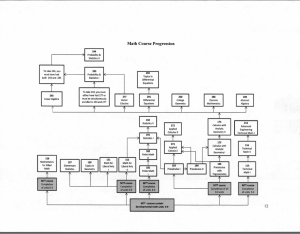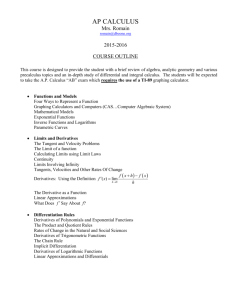Course Syllabus - Fayetteville State University
advertisement

Fayetteville State University COLLEGE OF ARTS AND SCIENCES Department of Mathematics and Computer Science MATH 142- Calculus with Analytic Geometry I Fall 2011 “In case FSU must close for an emergency during the semester, instruction will continue using Blackboard.” I. Locator Information: Instructor: __ Dr. Xin Tang____ Course # and Name: Math 142 Calculus with Analytic __ Office Location: Lyons 120________________ Semester Credit Hours: 4 hours___________________ Office hours: MF 10:00am-1:00pm & 3:00pm-4:00pm___ Day and Time Class Meets:_______________________ Office Phone: 910-672-2206______________ Total Contact Hours for Class:_____________________ Email address:_xtang@uncfsu.edu___________ FSU Policy on Electronic Mail: Fayetteville State University provides to each student, free of charge, an electronic mail account (studentid@broncos.uncfsu.edu) that is easily accessible via the Internet. The university has established FSU email as the primary mode of correspondence between university officials and enrolled students. Inquiries and requests from students pertaining to academic records, grades, bills, financial aid, and other matters of a confidential nature must be submitted via FSU email. Inquiries or requests from personal email accounts are not assured a response. The university maintains open-use computer laboratories throughout the campus that can be used to access electronic mail. Rules and regulations governing the use of FSU email may be found at http://www.uncfsu.edu/policy/general/FSUE-mailFINAL II. Course Description: The first course of a three-semester sequence in calculus with analytical geometry, including studies of graphs, functions, limits, differentiation, application of differentiation, integration, and application of the definite integral. Prerequisites: MATH 129 and MATH 130 or MATH 131. A graphing calculator is required. III. Disabled Student Services: In accordance with Section 504 of the 1973 Rehabilitation Act and the Americans with Disabilities Act (ACA) of 1990, if you have a disability or think you have a disability, please contact the Center for Personal Development in the Spaulding Building, Room 155 (1 st Floor); 910-672-1203. IV. Textbook: CALCULUS Concepts & Contexts 4E by James Stewart – THOMPSON BROOKS/COLE Publication. V. Student Learning Outcomes –Upon completion of this course, students will be able to: Demonstrate the ability to solve limit and derivative problems in connection with the tangent line to a curve and the velocity of an object. Demonstrate the knowledge of differentiation rules with related concepts and the ability to apply L’Hopsital’s Rules to find a limit. Demonstrate the ability to apply the concepts of derivative and rate of change to various practical problems such as Newton’s Method in numerical analysis and optimization in applied sciences. Demonstrate the knowledge of integration theory and the Fundamental Theorem of Calculus. Demonstrate the ability to apply the integration technique and use mathematical software such as Maple to solve practical problems. VI. Course Requirements and Evaluation Criteria: Evaluation in the course shall be by continuous assessment. Mode of assessment would include homework assignments, chapter exams, class attendance and participation, and final examination. The grading scale for determining the course grade and weights given to various activities are given below. a. b. c. d. A = 92-100% B = 83-91% C=73-82% D=64-72% F=Below 64% Students are only allowed to miss less than 3 classes for acceptable reasons. Homework: 30 points; Tests (the lowest grade will be dropped): 45 points; Final Exam: 25 points; 5 bonus points for proper attendance, participation and quizzes. No make-up exams or late assignments will be accepted without a legitimate reason. Should you expect to miss an exam, you need to get instructor’s approval for a possible makeup in advance. GENERAL REQUIREMENTS: The student is expected to pre-study each lesson in advance, complete all assignments, and spend adequate time on class work to insure success in the course. At least two hours of study is expected for each class hour. It is the responsibility of the student to avail himself/herself at all class meetings, and obtain additional help as needed. Consult the University Catalogue on Class Attendance Policy. Students are expected to enter the classroom on time and remain until the class ends. Late arrivals and early departures without appropriate excuses will not be tolerated. VII. Each student is encouraged to participate in class discussion for a clearer understanding and meet with the instructor when additional assistance is needed. Academic Support Resources: Additional information or announcement will be posted at Blackboard. VIII. Course Outline and Homework Assignments: *The following Course Outline and Assignments are subject to change if needed.* Class Topic Covered Assignment 1 1.1: 1, 30, 39,45 1.2: 10 1.3: 29, 31, 50, 51 1.4: 26 1.5: 30, 32 1.6: 22, 49 1.7: 5, 9, 13 2.1: 1, 6, 7 2.2: 1, 2, 5, 18, 29 2.3: 1, 2, 6, 10, 12, 13, 18, 19, 30 2.4: 4, 11, 15, 16, 17, 27, 29, 30, 39, 41 2.5: 3, 4, 5,15, 16, 20 2.5: 22, 23, 24, 37, 42, 55 2.6: 1,6,8,14,16,27, 43,45,50 2.7: 19, 21, 23 2.8: 2, 15 2 3 4 5 6 7 8 9 10 11 12 13 14 15 16 17 18 19 20 21 22 23 24 25 26 27 28 29 30 31 1.1 Four Ways to Represent a Function 1.2 Mathematical Models: A Catalog of Essential Functions 1.3 New Functions from Old Functions 1.4 Graphing Calculators and Computers 1.5 Exponential Functions 1.6 Inverse Functions and Logarithmic Functions 1.7 Parametric Curves 2.1 The Tangent and Velocity Problems 2.2 The Limit of a Function 2.3 Calculating Limits Using the Limit Laws 2.4 Continuity 2.5 Limits Involving Infinity 2.5 Limits Involving Infinity 2.6 Derivatives and Rates of Change 2.7 The Derivative as a Function 2.8 What does f’ say about f ? Review for Exam 1 Exam 1 3.1 Derivatives of Polynomials and Exponential Functions 3.2 The Product and Quotient Rules 3.3 Derivatives of Trigonometric Functions 3.4 The Chain Rule 3.4 The Chain Rule 3.5 Implicit Differentiation 3.6 Inverse Trigonometric Functions and Their Derivatives 3.7 Derivatives of Logarithmic Functions 3.8 Rate of Changes in Natural and Social Sciences 3.9 Linear Approximations and Differentials Review for Exam 2 Exam 2 4.1 Related Rates 4.2 Maximum and Minimum Values 4.2 Maximum and Minimum Values 4.3 Derivatives and the Shape of Curves 4.4 Graphing with Calculus and Calculators 4.5 Indeterminate Forms and L’Hospital’s Rule 4.6 Optimization Problems 3.1: 3, 4, 5, 6, 7, 14, 17, 19, 29, 46 3.2: 3, 4, 8, 12, 25, 31, 41, 50 3.3: 1, 2, 3, 4, 5, 10, 20 3.4: 8, 9, 10, 18, 21, 23 3.4: 31, 51, 79 3.5: 3, 5, 8, 24 3.6: 17, 18, 19, 22, 27 3.7: 2, 3, 4, 7, 8, 9,10, 33 3.8: 1(a, b, c, d, g), 8, 10, 29 3.9: 7, 8, 15, 16, 28 4.1: 2, 3, 9, 13, 14 4.2: 24, 25, 29 4.2: 42, 46, 50 4.3: 7, 8, 10, 21, 33 4.4: 1 4.5: 5, 9, 10, 19, 31 4.6: 5, 15, 26 32 33 34 35 36 37 38 39 40 41 42 4.7 Newton’s Method 4.8 Anti-derivatives Review for Exam 3 Exam 3 5.1 Areas and Distances 5.2 The Definite Integral 5.3 Evaluating Definite Integrals 5.4 The Fundamental Theorem of Calculus Review for Exam 4 Exam 4 Review for Final Exam Review for Final Exam Final Exam 4.7: 5, 11 4.8: 2, 5, 8, 12, 13, 15, 19 5.1: 4, 11 5.2: 2, 22, 36, 42, 43 5.3: 1, 4, 6, 7, 8, 15, 24, 33 5.4: 3, 7, 8, 9, 14 IX. Teaching Strategies: The majority of the material of the course will be given in lecture format. There is a short review before and after each lecture. Graphing calculators will be used in the class to help students develop a firm grasp of the underlying mathematical concepts. Student discussions, cooperative learning groups will be strongly encouraged. X. Bibliography: Howard Anton, Calculus: A New Horizon, John Wiley & Sons, 1998. Richard Courant and John Fritz, Introduction to Calculus and Analysis, Springer-Verlag, 1999. Earl W. Swokowski, Calculus with Analytic Geometry, PWS-Kent Publishing Company, 1994. C. H. Edwards and David E. Penny, Calculus with Analytic Geometry, Prentice-Hall, 1997. S. I. Grossman and Richard B. Lane, Calculus, Saunders College Pub.1997 G. B. Thomas and R. L. Fnney, Calculus with Analytic Geometry, Addison-Wesley Publishing Company, 1996. James Stewart, Calculus, Brooks/Cole Pub. Co., 2001. James Stewart, CALCULUS Concepts & Contexts 3E, THOMPSON BROOKS/COLE Publication, 2005.




